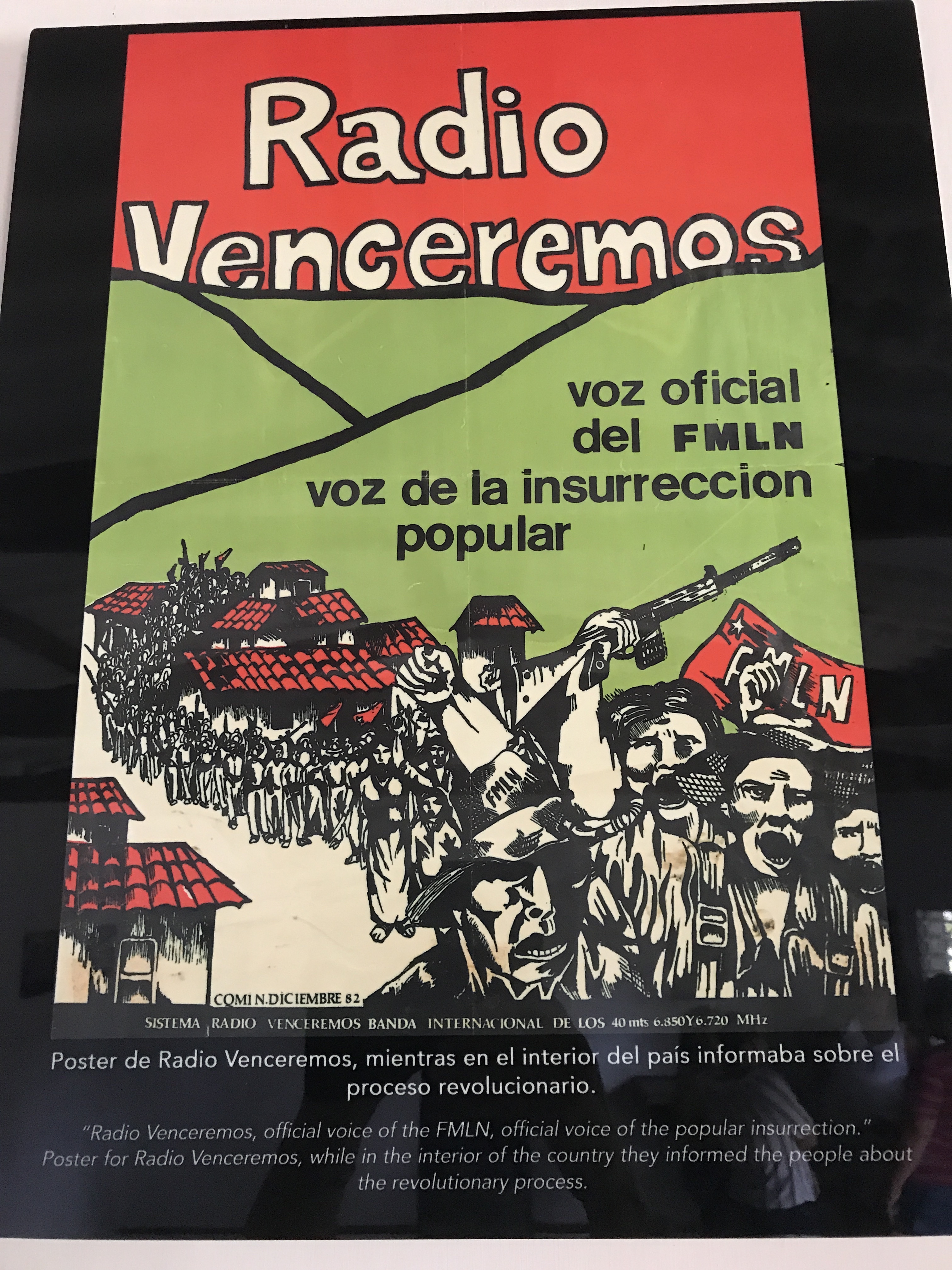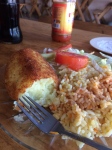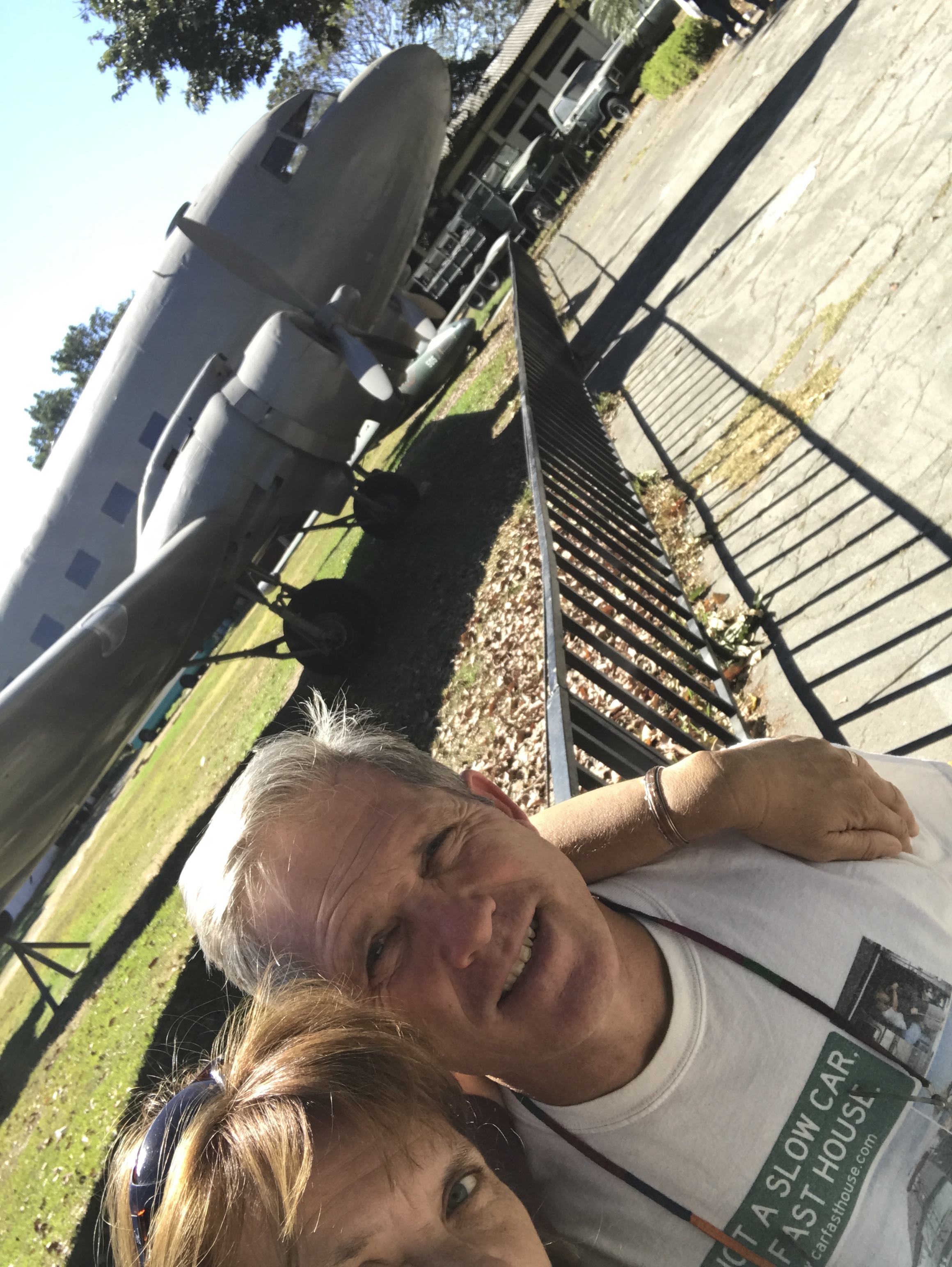Learning about the civil war in El Salvador was a bit of a surprise to us on many levels. We learned that it was fairly recent (1982). We learned that it was well-funded and supplied by the USA. We learned that it ravaged the county and left damages that are still being managed.
Here are some photos of our explorations about this subject. But if you want to read more, I would suggest the following links. (clicking on these will open a new window)  Even now, the country has an abundance of military, police and private security patrols. This man was stationed at the entrance to a campground where we stayed. It was 6 miles from a village and had no electricity at night. There was no visible threat or danger to us at all. But he stood vigil near the gate during daylight hours. I am not sure where he went at night, as we were the only ones at the lake once the sun went down!
Even now, the country has an abundance of military, police and private security patrols. This man was stationed at the entrance to a campground where we stayed. It was 6 miles from a village and had no electricity at night. There was no visible threat or danger to us at all. But he stood vigil near the gate during daylight hours. I am not sure where he went at night, as we were the only ones at the lake once the sun went down!
In the capital, San Salvador, we visited the Military History Museum. The machinery at this museum was fairly new and clearly bore the manufacture labels of USA military products. Also in this museum was a room dedicated to the presidents of various countries around the world, including the United States of America. Notice where the portrait display ended? I guess this “shithole country” hasn’t had time to print a portrait just yet. Its only been a year!

 Come on now, don’t get mad. I seldom ever make mention of politics or religion on this blog. Let me have some fun! Okay, here is something to lighten it up, who doesn’t love THE POPEMOBILE!!! Yes, the pope visited El Salvador in 1996 and they built this special rig for him. It is also on display at the Military Museum, of course!
Come on now, don’t get mad. I seldom ever make mention of politics or religion on this blog. Let me have some fun! Okay, here is something to lighten it up, who doesn’t love THE POPEMOBILE!!! Yes, the pope visited El Salvador in 1996 and they built this special rig for him. It is also on display at the Military Museum, of course!  But let’s go out to some villages and explore the civil war a little differently. Here are some images from a village named Cinquera. On the wall of this building is a list of the lives lost during the war from just this department (like a county)
But let’s go out to some villages and explore the civil war a little differently. Here are some images from a village named Cinquera. On the wall of this building is a list of the lives lost during the war from just this department (like a county)  And in their town square, where most villages have a gazebo or a sculpture of a famous person. This village commemorates that which lefts it mark upon them. An American made helicopter (a Huey) which was shot down and rained debris over their people. And along the fence, military weapons, also made in the USA.
And in their town square, where most villages have a gazebo or a sculpture of a famous person. This village commemorates that which lefts it mark upon them. An American made helicopter (a Huey) which was shot down and rained debris over their people. And along the fence, military weapons, also made in the USA.  This small community is fighting a new war now, as illustrated on this mural. These are strong, proud people who are not afraid to stand up for what they feel is right. At any price.
This small community is fighting a new war now, as illustrated on this mural. These are strong, proud people who are not afraid to stand up for what they feel is right. At any price.  Another town we visited suffered a horrific incident during the war. It was a deadly game of trickery in 1981, whereby the people were offered safety and respite in the village of El Mozote. This area was known for its neutrality. But then a group of military arrived. There were rapes, horrible murders and mass graves which held the elderly, women and children. Only one woman survived to tell the tale. You can read more about it here EL Mozote Massacre and here El Mozote Massacre It is not a great resource, but you can follow the links and delve further if you are interested. This was a grisly situation that continues to bear controversy.
Another town we visited suffered a horrific incident during the war. It was a deadly game of trickery in 1981, whereby the people were offered safety and respite in the village of El Mozote. This area was known for its neutrality. But then a group of military arrived. There were rapes, horrible murders and mass graves which held the elderly, women and children. Only one woman survived to tell the tale. You can read more about it here EL Mozote Massacre and here El Mozote Massacre It is not a great resource, but you can follow the links and delve further if you are interested. This was a grisly situation that continues to bear controversy.
 This sorrowful memorial resides in the town park, where many of the killings took place and were displayed. A nearby home still bears the scars of bullet wounds and fire as a testament to the sadness that happened here. This is just steps away from the town park.
This sorrowful memorial resides in the town park, where many of the killings took place and were displayed. A nearby home still bears the scars of bullet wounds and fire as a testament to the sadness that happened here. This is just steps away from the town park. And on a hilltop nearby, a beautiful memorial to martyrs has been erected. This wonderful monument features life-sized sculptures of Mahatma Gandhi, Mother Teresa, Pope John Paul II and Martin Luther King. It was a beautiful, sunny day when we visited and the peacefulness of the location resonated from the memorial.
And on a hilltop nearby, a beautiful memorial to martyrs has been erected. This wonderful monument features life-sized sculptures of Mahatma Gandhi, Mother Teresa, Pope John Paul II and Martin Luther King. It was a beautiful, sunny day when we visited and the peacefulness of the location resonated from the memorial. 
 The figures on the top represent the families of the El Mozote region. They are the same outline shape as the memorial in the center of the village. The life-sized martyrs are on platforms down below each of the buttresses.
The figures on the top represent the families of the El Mozote region. They are the same outline shape as the memorial in the center of the village. The life-sized martyrs are on platforms down below each of the buttresses.
Our next visit was to the town of Perquin. This is located in the northern mountains of El Salvador. In this region the civilians were able to fight a strong battle due to their knowledge of the terrain. But this area was also ravaged by the air strikes, bombs and fires from the Army. In Perquin there is a stark and dramatic museum which offers great information about the war. Here are a few images from that museum.

And a very important part of fighting this war was the use of a secret radio station. It served to communicate information, share facts and help keep the morale of the civilians strong. The Radio Venceremos ( we will overcome) was the official voice of the civilian uprising. It was troublesome to the military, and they worked hard to destroy it, without success. This radio station will always represent freedom to the people of El Salvador.  The neighboring countries of Nicaragua and Guatemala and Honduras were also experiencing effects of the war. But they each had issues of their own to manage as well.
The neighboring countries of Nicaragua and Guatemala and Honduras were also experiencing effects of the war. But they each had issues of their own to manage as well.  The museum in Perquin also had an outdoor area that showed some of the guerrilla camp areas, foxholes, hanging bridges, rough camp kitchens, holes from bombs, military debris, home-made weapons includes grenades, bombs and other explosive devices used by both groups during this war. The sign above the bomb says: this is a 500lb bomb made by the USA in August 1981. It sits on display in front of a huge crater in the ground behind the museum.
The museum in Perquin also had an outdoor area that showed some of the guerrilla camp areas, foxholes, hanging bridges, rough camp kitchens, holes from bombs, military debris, home-made weapons includes grenades, bombs and other explosive devices used by both groups during this war. The sign above the bomb says: this is a 500lb bomb made by the USA in August 1981. It sits on display in front of a huge crater in the ground behind the museum.
We camped outside a lovely hotel owned by an American man. The Perquin Lenca hotel is just one of his investments in this country. He also works to support a local school. Ron Brenneman came to El Salvador as a young missionary in 1981, in the midst of a civil war. He has stayed on and written about his experience. Here is a link to the book Perquin Musings
 Of course we also enjoyed some good food while learning all this history. And met a few cute dogs on the road. This sweet guy hung out for a couple of days and shared bones with Zeb. He was surprisingly mobile, even though one his back legs is reversed. Likely an untreated broken leg. But he works at a hotel parking lot and does a great job there!
Of course we also enjoyed some good food while learning all this history. And met a few cute dogs on the road. This sweet guy hung out for a couple of days and shared bones with Zeb. He was surprisingly mobile, even though one his back legs is reversed. Likely an untreated broken leg. But he works at a hotel parking lot and does a great job there! This has been a hard post to write. It is a tough topic to learn about. Especially as we are enjoying the incredibly friendly people of this country. But as I write this blog and reflect on our travels, I cannot help but be thankful for our freedoms, our safety and for this incredible journey that we are experiencing. So I will leave you with this silly photo of Zeb, doing what he does best.
This has been a hard post to write. It is a tough topic to learn about. Especially as we are enjoying the incredibly friendly people of this country. But as I write this blog and reflect on our travels, I cannot help but be thankful for our freedoms, our safety and for this incredible journey that we are experiencing. So I will leave you with this silly photo of Zeb, doing what he does best. 












Like always so well done and love all your educationals aspects!
i LOVE this post!! I never knew about this civil war either. Gee, I wonder why we didn’t learn about it in school??
And well, i wonder if they will ever put a pic of the Orange Menace on their wall in that museum? Better to not deface it. 🙂
So many thoughts as I read through your post. We really are lucky to live with so many freedoms.